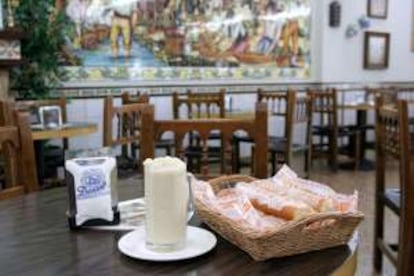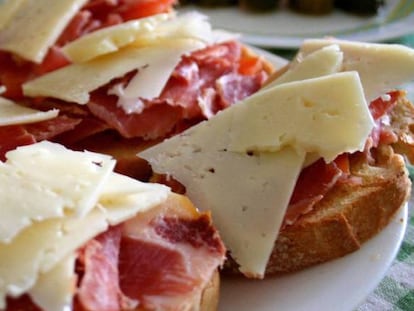Chufa, the super food from Valencia
The tuber known in English as tiger nut is widely used here to make a popular drink called horchata

Very popular in Spain’s Valencia region, the chufa is the edible tuber produced by the plant Cyperus esculentus, and is generally known in English as “tiger nut.” The chufa is used to make horchata, a milky-looking drink that is an excellent thirst-quencher in the hot, humid Mediterranean summers.
The consumption of chufa was already documented in Ancient Egypt: it seems like the pharaohs appreciated its flavor, and vestiges of the tuber have been found in their sarcophagi. From there, the plant expanded throughout northern Africa and Arab invaders brought it into the Iberian peninsula, where the Mediterranean soil proved to be very well adapted to its cultivation. Because alcoholic drinks are forbidden by Islam, the faithful began drinking chufa milk, which is at the origin of today’s horchata valenciana.
Horchata should be ideally consumed fresh on the spot
These days, the town of Alboraya, just outside the city of Valencia, is the epicenter of horchata production. Its readily recognizable landscape, featuring mile upon mile of chufa fields, produces a delicately flavored drink that should be ideally consumed fresh on the spot, as the bottling process inevitably makes it lose properties and alters its characteristic taste.
New chufa products
We are living in times that demand permanent renewal, and the age-old tradition of drinking an horchata in Alboraya has been enhanced with all kinds of innovative perks offered by horchata makers.
Daniel Tortajada, born in Alboraya in 1933, began making horchata for his family, then opened an establishment in 1960 in the ground floor of his own house. In 1979, he inaugurated an horchatería named Daniel on a road that would eventually come to be known as Avinguda de l’Orxata (Horchata Avenue, in the Valencian language), connecting Alboraya and Valencia. The place soon began receiving illustrious visitors such as the poet Rafael Alberti and the Surrealist artist Salvador Dalí.

In 1982, when the Association of Artisan Horchata Makers was founded, Daniel Tortajada became its first president. Since then, two more generations of Tortajadas have taken the reins of the business, which expanded in 2013 with a new establishment inside Colón Market, in the city of Valencia. The original product is still on offer, but so are innovative byproducts such as chufa cookies and chufa ice cream.
This innovative spirit has now extended throughout Alboraya. The most recent example can be found at Sequer lo Blanch, located on a road called Fondo de Alboraya. Besides functioning as an horchatería, this place doubles as an arrocería (an eatery specializing in rice dishes) and also organizes cultural activities. Its manager, José Belloch, likes to experiment with the star product of this land and now serves up such unusual creations as chufa alioli (an oil-and-garlic spread), chufa chocolate and even a chufa beer called Cambra.
The chufa is often spoken about as a super-food. The Oxford English Dictionary calls it a “nutrient-rich food” that is considered especially beneficial to health and wellbeing. The nutrient-rich tiger nut helps with digestion, it protects the heart, it is an anti-oxidant, it stimulates the immune system, it works as an antacid, and it contains no lactose or gluten, making it a good option for people with intolerance to the latter. It also plays a leading role in cholesterol control, as its high level of oleic acid (77%) is similar to olive oil.
And the best part is that it is now available year-round, at very affordable prices.
Joan Garí is the author of L’única passió noble (published by Onada).
English version by Susana Urra.
Tu suscripción se está usando en otro dispositivo
¿Quieres añadir otro usuario a tu suscripción?
Si continúas leyendo en este dispositivo, no se podrá leer en el otro.
FlechaTu suscripción se está usando en otro dispositivo y solo puedes acceder a EL PAÍS desde un dispositivo a la vez.
Si quieres compartir tu cuenta, cambia tu suscripción a la modalidad Premium, así podrás añadir otro usuario. Cada uno accederá con su propia cuenta de email, lo que os permitirá personalizar vuestra experiencia en EL PAÍS.
¿Tienes una suscripción de empresa? Accede aquí para contratar más cuentas.
En el caso de no saber quién está usando tu cuenta, te recomendamos cambiar tu contraseña aquí.
Si decides continuar compartiendo tu cuenta, este mensaje se mostrará en tu dispositivo y en el de la otra persona que está usando tu cuenta de forma indefinida, afectando a tu experiencia de lectura. Puedes consultar aquí los términos y condiciones de la suscripción digital.
More information
Archived In
Últimas noticias
The complicated life of Francesca Albanese: A rising figure in Italy but barred from every bank by Trump’s sanctions
Reinhard Genzel, Nobel laureate in physics: ‘One-minute videos will never give you the truth’
Pinochet’s victims grapple with José Antonio Kast’s rise in Chile
Half of Scotland is in the hands of 420 property owners
Most viewed
- Pablo Escobar’s hippos: A serious environmental problem, 40 years on
- Reinhard Genzel, Nobel laureate in physics: ‘One-minute videos will never give you the truth’
- Why we lost the habit of sleeping in two segments and how that changed our sense of time
- Charles Dubouloz, mountaineering star, retires at 36 with a farewell tour inspired by Walter Bonatti
- The Florida Keys tourist paradise is besieged by immigration agents: ‘We’ve never seen anything like this’










































